Martial arts have captivated the human imagination for centuries, embodying discipline, strength, and grace. Karate is a formidable and revered art form among the many martial arts practiced worldwide. With its origins deeply rooted in ancient Japan, Karate has evolved over centuries, blending physical techniques with philosophical principles. In this blog, we will delve into the fascinating history, principles, and cultural significance of Karate.
Key Takeaways:
- Karate is a formidable and revered martial art with deep roots in ancient Japan.
- It blends physical techniques with philosophical principles.
- Karate has cultural significance and embodies principles of discipline, respect, and self-improvement.
- It offers numerous benefits, including fitness, self-confidence, stress reduction, and personal growth.
- There are various styles, techniques, and training methods in Karate.
Origins and Historical Development
Karate, a fascinating martial art, traces its roots back to the Ryukyu Kingdom, located in Okinawa, Japan. This archipelago became the birthplace of Karate during a time of political unrest and the prohibition of weapons. It was in this context that the foundations of Karate were laid, as the locals sought alternative means of self-defense.
Chinese martial arts, particularly Kung Fu, played a crucial role in the development of Karate. Chinese traders and emissaries brought with them their fighting techniques to Okinawa, where they synergistically blended with the indigenous traditions, giving rise to the unique martial art known as Karate.
The fusion of Chinese influence on Karate resulted in a martial art that encompassed both striking and grappling techniques, as well as a philosophical understanding of combat. Over time, Okinawa became a melting pot of diverse martial arts styles, contributing to the evolution and refinement of Karate.
Principles and Philosophy
Karate is more than just a physical combat system; it embodies a philosophy that emphasizes self-discipline, respect, and self-improvement. The word “Karate” itself translates to “empty hand,” signifying the art’s focus on unarmed techniques. Practitioners of Karate adhere to a set of principles that guide their training and character development.
Discipline is a fundamental principle in Karate. It teaches practitioners the importance of self-control, perseverance, and commitment. By following a structured training regimen and adhering to specific guidelines, practitioners cultivate discipline in all areas of their lives.
Respect is another core principle in Karate. It encompasses respect for oneself, instructors, training partners, and the art itself. Respect is demonstrated through proper etiquette, humility, and appreciation for the knowledge and experience shared by others.
The mind-body connection is an integral aspect of Karate training. It emphasizes the unity of the mind and body, focusing on developing mental acuity, concentration, and body awareness. Through continuous practice, practitioners cultivate a deep understanding of the mind-body connection and harness it to enhance their overall performance.
Self-defense is a core component of Karate. While techniques are honed for physical combat, the art also promotes self-defense as a means of protecting oneself and others. Practitioners learn techniques that enable them to assess threats, respond effectively, and neutralize physical confrontations.
Continuous improvement is a central tenet of Karate philosophy. Practitioners strive to continuously refine their techniques, physical abilities, and character. This commitment to growth fosters a mindset of self-reflection, adaptability, and the pursuit of excellence.
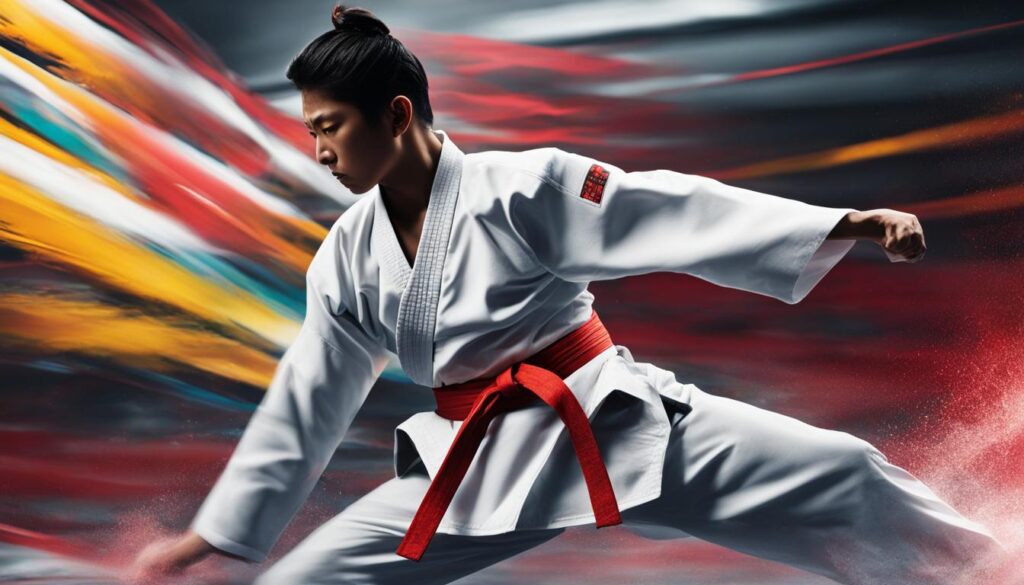
“Karate is not solely about physical prowess; it is a way of life that nurtures discipline, respect, and self-improvement. The principles and philosophy of Karate guide practitioners to cultivate mental and physical strength, promoting harmony and personal growth.”
Cultural Significance
Karate is not just a martial art; it embodies the cultural heritage and identity of Okinawa and Japan. Its practice is deeply ingrained in Japanese society and extends beyond physical training. The art promotes humility, perseverance, and integrity, which permeate Japanese culture.
The cultural significance of karate can be seen in its historical roots and the values it upholds. Originally developed in Okinawa, karate draws upon the traditions and philosophies of ancient Japan. It reflects the core principles of discipline, respect, and self-improvement that are highly valued in Japanese society.
In Japanese culture, humility is a prized virtue, and karate emphasizes its importance. Practitioners are taught to approach training with a sense of humility, recognizing that there is always more to learn and improve upon. This humility extends beyond the dojo (training hall) and influences the way karateka (karate practitioners) interact with others in daily life.
Perseverance is another fundamental value in karate. The rigorous training and dedication required to master the art instill a sense of perseverance that carries over into other aspects of life. Karateka learn the importance of setting goals, working hard, and pushing through challenges to achieve success.
Integrity is deeply ingrained in the practice of karate. The art emphasizes honesty, fairness, and moral character, both on and off the training mat. Karateka strive to uphold these principles in their interactions with others, fostering a sense of integrity that extends into all areas of their lives.
Karate in the Modern World
Karate, once confined to the shores of Okinawa, has transcended geographical boundaries to become a global phenomenon. In the early 20th century, esteemed masters introduced Karate to Japan, setting the stage for its rapid proliferation. Today, this martial art is practiced by millions worldwide, captivating enthusiasts of all ages and backgrounds.
Karate’s popularity is not limited to its physical aspects; it has also gained recognition as an Olympic sport. The inclusion of Karate in the Olympic Games has further propelled its visibility, highlighting its significance on the world stage. As an Olympic sport, Karate showcases the art’s technical prowess, grace, and competitive spirit.
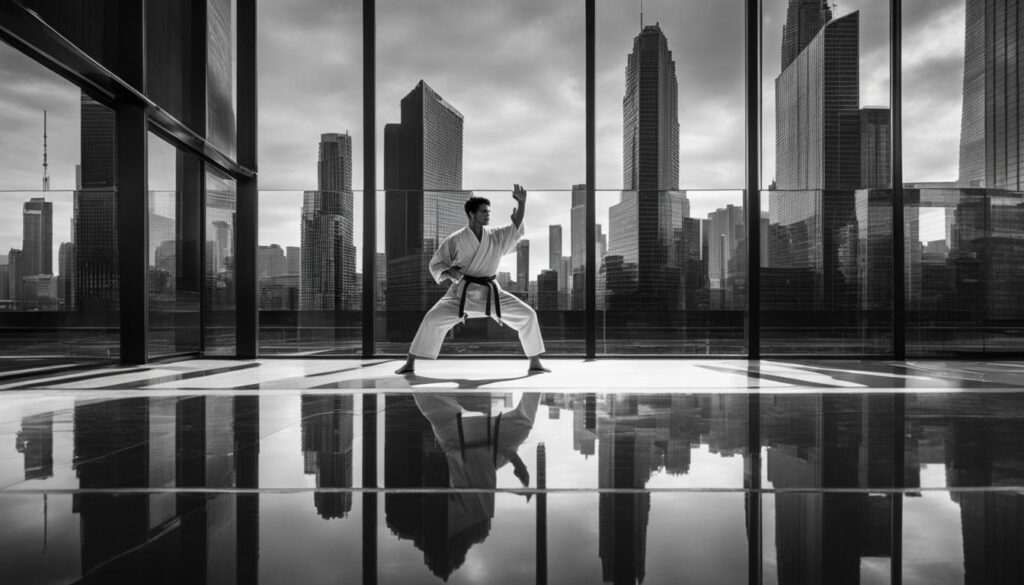
Yet, Karate encompasses more than just competition and skill. It offers individuals a pathway for personal growth, self-defense, and the development of resilience. Practitioners of Karate embark on a journey that extends beyond the physical realm, fostering discipline, mental fortitude, and self-awareness. The art empowers individuals to overcome challenges, both within and outside the dojo.
Whether you seek self-improvement, personal growth, or the ability to defend yourself, Karate provides an enriching and rewarding experience that resonates in the modern world.
Benefits of Karate
Beyond physical training, Karate offers numerous benefits that contribute to overall well-being and personal growth. Whether you are seeking improved fitness, self-confidence, or stress reduction, Karate provides a holistic approach to physical and mental development.
Improved Fitness: Karate is a dynamic martial art that engages the entire body, leading to improved stamina, flexibility, and strength. The rigorous training routines, including a variety of striking, kicking, and blocking techniques, promote cardiovascular health and muscular endurance.
Enhanced Coordination: Karate practitioners develop exceptional hand-eye coordination and body control through precise movements and techniques. This heightened coordination translates into better balance, agility, and overall motor skills.
Boosted Self-Confidence: Karate instills a sense of self-assurance through consistent training and achievement. As you progress in skill and earn higher belt ranks, your confidence grows, reflecting your dedication and mastery of the art.
Mental Fortitude and Stress Reduction: Karate training goes beyond physical exertion; it cultivates mental resilience and discipline. By focusing on techniques, practicing katas (sequences of movements), and sparring, practitioners develop heightened mental clarity, concentration, and the ability to manage stress effectively.
Values Learned: Karate training imparts valuable life skills and values that extend beyond the dojo. Disciplined practice fosters a strong work ethic, perseverance, respect for oneself and others, and a deep sense of integrity that can positively impact personal relationships, academics, and career pursuits.
Experience the transformative power of Karate, harnessing its physical and mental benefits to enhance your well-being, cultivate self-confidence, and develop valuable life skills.
Karate Styles
When it comes to Karate, there are various styles to explore, each with its unique characteristics and techniques. Whether you are a beginner or an experienced practitioner, understanding the different styles can help you find the one that resonates with you the most.
Here are some popular karate styles:
Shotokan Karate
Shotokan Karate is one of the most widely practiced and recognized styles worldwide. It focuses on powerful strikes, linear movements, and strong stances. Shotokan practitioners emphasize discipline, controlled breathing, and kata (predefined forms) to develop strength, speed, and accuracy in their techniques.
Okinawan Karate
Okinawan Karate, originating from the Ryukyu Islands in southern Japan, has a rich history and distinct techniques. This style places emphasis on the practical application of techniques in self-defense scenarios. Okinawan Karate incorporates strikes, joint locks, and throws to neutralize an opponent’s attacks.
Wado-Ryu Karate
Wado-Ryu Karate, founded by Hironori Otsuka, combines elements of Karate and Jujutsu. With its emphasis on fluid and evasive movements, Wado-Ryu focuses on redirecting an opponent’s energy while simultaneously delivering effective strikes. This style also incorporates throws and takedowns, making it versatile in close combat situations.
Goju-Ryu Karate
Goju-Ryu Karate, known for its circular and hard-soft techniques, is characterized by its emphasis on close-range combat and the development of internal power. This style utilizes both linear and circular movements, combining powerful strikes with grappling and joint-locking techniques. Goju-Ryu practitioners also focus on breathing exercises to cultivate internal strength.
These popular Karate styles offer a diverse range of training methods and philosophies. Each style has its own unique approach to self-defense, personal growth, and physical conditioning. Exploring different styles can enrich your understanding of Karate and help you find the one that aligns with your goals and interests.
Karate Techniques
Karate encompasses a wide range of techniques that form the foundation of this martial art. These techniques, including strikes, kicks, blocks, punches, and grapples, are essential for developing proficiency and effectiveness in self-defense.
When it comes to karate strikes, practitioners learn the art of delivering powerful blows to specific targets on an opponent’s body. These strikes are executed with precision and speed, utilizing a combination of hand, fist, and elbow techniques.
Karate kicks are an integral part of the art, focusing on generating power and accuracy through a variety of kicking techniques. From front kicks to roundhouse kicks, each technique aims to strike opponents with force while maintaining balance and flexibility.
Effective karate blocks play a crucial role in self-defense, allowing practitioners to defend against incoming attacks. These blocks involve using the arms, hands, and legs to intercept and neutralize strikes, redirecting the opponent’s energy away from the defender.
Karate punches are designed to deliver forceful strikes using the hands and knuckles. Practitioners employ various punch techniques, such as straight punches, hooks, and uppercuts, honing their power and accuracy through training and practice.
In addition to strikes and punches, karate grapples are utilized to gain control over an opponent’s body. These grappling techniques involve joint locks, throws, and immobilization, enabling practitioners to neutralize threats in close-quarters combat.
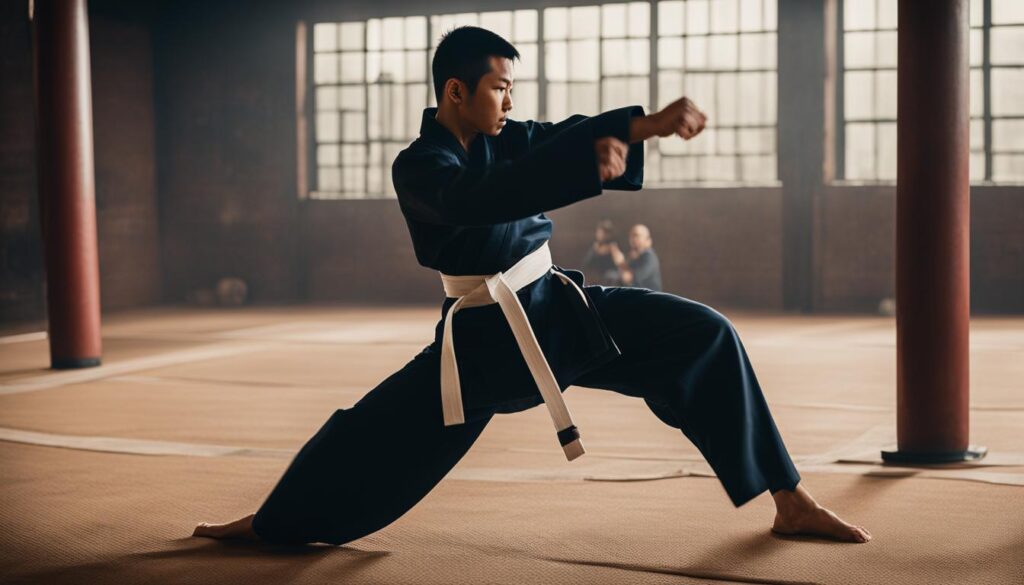
Mastering these karate techniques requires dedication, discipline, and regular practice. By honing their skills in strikes, kicks, blocks, punches, and grapples, karate practitioners gain the ability to defend themselves effectively and perform with precision in both training and real-world scenarios.
Karate Training
Enrolling in karate training is a crucial step towards mastering this ancient martial art. With experienced instructors leading classes, you’ll embark on a journey of self-improvement and skill development. The karate curriculum is designed to enhance your abilities through a combination of drills, katas, and sparring sessions.
During the training process, you’ll have the opportunity to refine your techniques, build strength and endurance, and cultivate discipline. The guidance of knowledgeable instructors ensures that you receive proper guidance and feedback on your progress.
One key aspect of karate training is the belt system. This system allows you to measure your proficiency and advancement in the art. As you progress through the ranks, you’ll earn higher belts, symbolizing your growth and dedication. The karate belt system serves as a visual representation of your skill level, motivating you to continue pushing yourself further.
Take a look at the illustration below to understand the typical progression of the karate belt system:
| Belt Level | Description |
|---|---|
| White | The starting point of the journey, signifying a beginner’s status. |
| Yellow | Indicates the first step towards proficiency, reflecting a beginner’s understanding of basic techniques. |
| Orange | Represents progress in skill development and knowledge acquisition. |
| Green | Symbolizes growth and a deeper understanding of karate principles. |
| Blue | Reflects further improvement and refinement of techniques. |
| Purple | Represents adeptness in karate, showcasing advanced skill and dedication. |
| Brown | Signifies high proficiency and knowledge, marking the transition towards mastery. |
| Black | The ultimate goal for many practitioners, symbolizing expertise and the role of a teacher. |
Karate for Self-Defense
Karate is not only an art form but also an efficient self-defense system. It equips individuals with practical techniques to protect themselves in real-life situations.
When it comes to self-defense, karate emphasizes the use of efficient techniques that are specifically designed to neutralize an opponent quickly and effectively. By focusing on powerful strikes, precise kicks, and well-executed blocks, karate practitioners can efficiently defend themselves in various situations.
Evasion is another crucial aspect of karate for self-defense. By developing agility, quick reflexes, and keen awareness, practitioners can evade attacks and create opportunities to counter-attack.
Understanding an opponent’s vulnerabilities is also a fundamental concept in karate. By studying and analyzing an opponent’s movements, positioning, and weaknesses, karate practitioners can exploit these vulnerabilities to gain an advantage and effectively defend themselves.
Practical self-defense techniques, efficient execution, evasion skills, and knowledge of opponent vulnerabilities make karate an excellent choice for individuals seeking effective self-defense training.
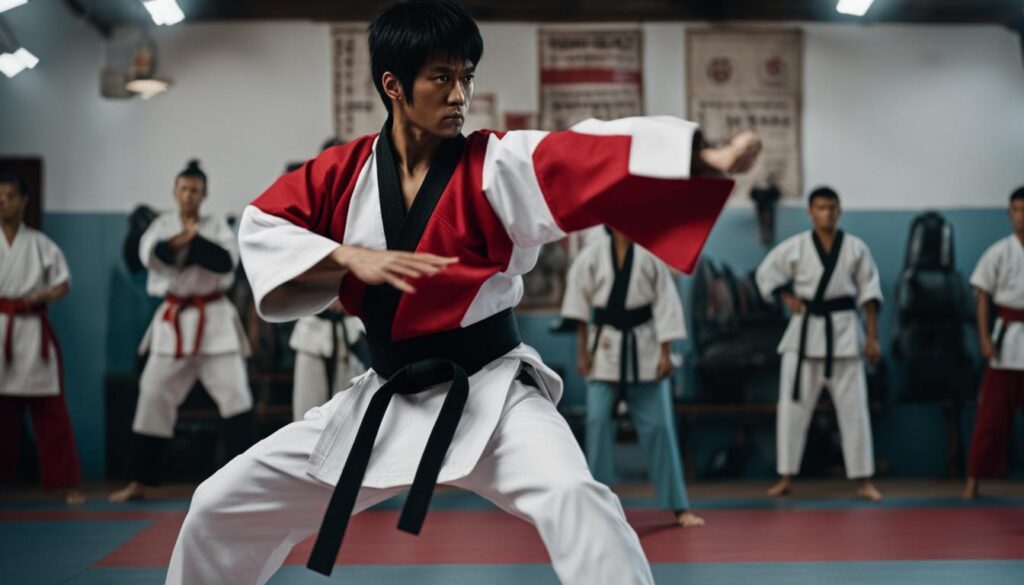
Karate Tournaments
Karate tournaments provide an exciting platform for practitioners to showcase their skills and compete against other passionate individuals. These events serve as a test of skill, strength, speed, and technique, allowing participants to gauge their abilities and growth within the discipline.
Competitive karate fosters a spirit of camaraderie and sportsmanship among practitioners, encouraging them to push their boundaries and strive for excellence. Whether you are a beginner or an experienced karateka, participating in tournaments can be a thrilling and rewarding experience, offering valuable opportunities for personal growth and learning.
Various organizations oversee these karate competitions, ensuring fair play and adherence to specific rules and regulations. These rules govern every aspect of the tournament, from the techniques allowed to the scoring criteria employed to determine winners.
Each tournament follows a systematic structure, with participants divided into different categories based on factors such as age, skill level, and weight divisions. This categorization ensures that competitors are matched with opponents of similar abilities, creating a level playing field for all.
During the tournament, fighters exhibit their skills in controlled matches, demonstrating their mastery of karate techniques and strategies. The bouts are often intense and fast-paced, showcasing the agility, precision, and power of the participants.
At the end of the tournament, winners are recognized and awarded based on their performance. These accolades serve as recognition of their hard work, dedication, and commitment to their karate journey.
Participating in karate tournaments not only allows practitioners to measure their progress but also serves as a valuable learning experience. Observing and competing against skilled opponents can provide valuable insights and inspiration for further improvement.
Whether you aspire to become a champion or simply desire to challenge yourself and experience the thrill of competition, karate tournaments offer an ideal platform to showcase your dedication, skill, and passion for the art.
Karate Belts and Ranking
Karate employs a belt system to denote a practitioner’s rank and progression. This ranking system allows students to track their growth and development as they advance in their karate journey. Each belt color represents a different level of expertise and knowledge within the art.
The karate belt system typically starts with a white belt, symbolizing a beginner. As students progress and demonstrate proficiency in their techniques, they earn higher belt ranks. The colors of the belts may vary depending on the specific style or organization, but some commonly used colors include:
- White Belt: The starting point for all beginners.
- Yellow Belt: Represents the first stage of progression.
- Orange Belt: Signifies a deeper understanding of the fundamental techniques.
- Green Belt: Indicates progress and growth in skills and knowledge.
- Blue Belt: Represents an intermediate level of expertise.
- Purple Belt: Demonstrates further advancement and dedication to the art.
- Brown Belt: Shows a high level of proficiency and mastery.
- Black Belt: The highest achievable rank in karate, symbolizing mastery and expertise.
Earning a higher karate belt requires hard work, dedication, and continuous improvement. Progression in karate is not solely based on technical skill but also encompasses the display of discipline, respect, and a deep understanding of the art. Each belt rank represents a milestone in a practitioner’s journey, marking their growth and achievements in karate.

Karate for Personal Growth
Karate is not just a martial art; it is a lifelong journey of personal development and self-discovery. Through dedicated practice and continuous improvement, practitioners have the opportunity to grow physically, mentally, and emotionally, fostering resilience and unleashing their full potential.
One of the core principles of karate is the pursuit of personal growth. By striving to refine their techniques and deepen their understanding of the art, practitioners embark on a transformative path of continuous learning and self-improvement.
Through the rigorous training and discipline of karate, individuals cultivate physical fitness, mental focus, and emotional well-being. The practice of karate requires dedication, perseverance, and self-discipline, all of which contribute to personal growth and development.
In addition to the physical benefits, karate offers a profound opportunity for self-discovery. As practitioners learn to master new techniques and face challenges, they gain a deeper understanding of their capabilities and inner strengths. This process of self-discovery fosters self-confidence, resilience, and a strong sense of self-awareness.
Karate is not merely about learning punches and kicks; it is a holistic practice that nurtures the mind, body, and spirit. By integrating the principles of discipline, respect, and continuous improvement, karate empowers individuals to cultivate personal growth and unleash their true potential.
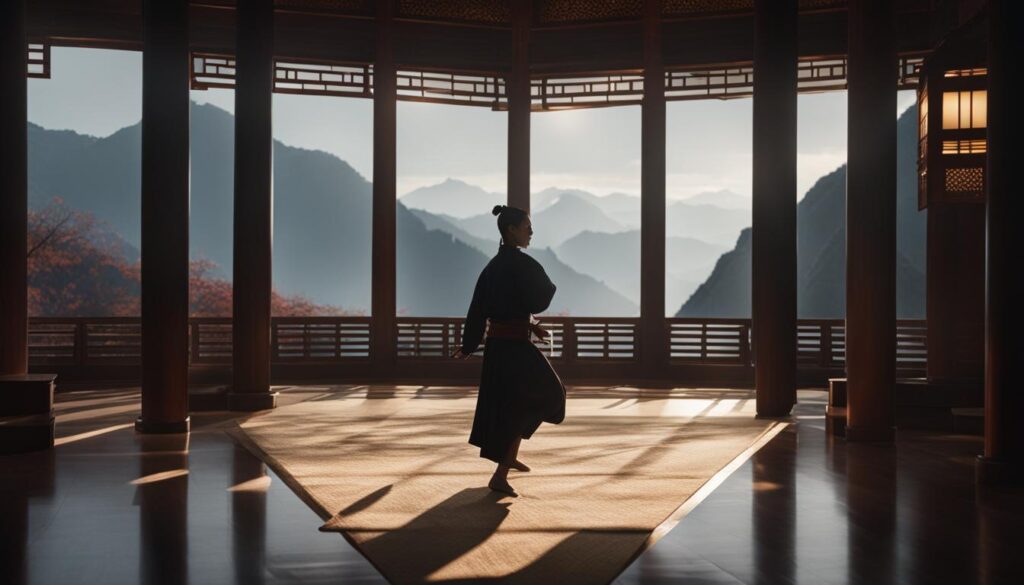
Karate Empowers Personal Growth and Self-Defense
Karate is a powerful martial art that goes beyond physical combat. It has the ability to transform individuals by promoting personal growth, building confidence, and equipping them with self-defense skills. Through its discipline, respect, and self-improvement principles, Karate guides practitioners on a journey of continuous growth and self-discovery.
One of the key aspects of Karate is its focus on personal development. As practitioners train and refine their techniques, they also cultivate important qualities such as perseverance, resilience, and mental fortitude. This process of continuous improvement extends beyond the training mat and into all aspects of life, empowering individuals to overcome challenges and reach their full potential.
In addition to personal growth, Karate also provides valuable self-defense skills. The techniques learned in Karate are practical and effective, teaching individuals how to protect themselves in real-life situations. Through training, practitioners gain the knowledge and confidence to assess threats, react swiftly, and defend themselves effectively.
Moreover, Karate instills a sense of empowerment in individuals. By mastering techniques and overcoming physical and mental barriers, practitioners build confidence in their abilities. This newfound confidence extends beyond the realms of self-defense, positively impacting other areas of their lives. Whether it’s public speaking, career challenges, or personal relationships, the confidence gained from Karate allows individuals to tackle obstacles with a sense of assurance.
Through the practice of Karate, individuals not only develop physical strength, but also inner strength. They learn to harness their mental and emotional capabilities, cultivating focus, discipline, and clarity of mind. Karate becomes a vehicle for self-empowerment, enabling individuals to overcome limitations, push boundaries, and embrace their true potential.
Ultimately, Karate offers a holistic approach to personal growth and self-defense. It provides the tools and mindset needed to face life’s challenges head-on, while fostering a sense of empowerment and building confidence. Whether you are seeking personal development, self-defense skills, or both, Karate has the power to transform your life and unlock your true potential.
Conclusion
Karate, with its ancient origins and rich historical background, stands as a unique and revered martial art. Its principles of discipline, respect, and self-improvement extend far beyond physical combat, guiding practitioners on a continuous journey of growth and self-discovery.
Whether your goal is to improve your physical fitness, acquire self-defense skills, or gain a deeper understanding of Japanese culture, Karate provides a profound and rewarding experience. Through dedicated training and adherence to its philosophical foundations, Karate instills values such as perseverance, integrity, and humility, which can be applied to all aspects of life.
With various styles and techniques to explore, the training in Karate offers a comprehensive approach to both mind and body. It not only enhances physical strength, flexibility, and coordination but also fosters mental fortitude and stress reduction. As you progress through the ranks, the belt system signifies your proficiency and serves as a reminder of your journey towards mastery.
Embarking on a Karate journey means embracing a centuries-old tradition while reaping the benefits of personal growth, self-defense skills, and a greater sense of confidence. So, take the first step, find a reputable Karate training program, and experience the transformative power of this ancient art for yourself.
FAQ
What is karate?
Karate is a martial art that originated in Okinawa, Japan, combining physical techniques with philosophical principles. It focuses on unarmed self-defense techniques, promoting discipline and continuous self-improvement.
What are the different styles of karate?
Some popular styles of karate include Shotokan Karate, Okinawan Karate, Wado-Ryu Karate, and Goju-Ryu Karate. Each style has its own unique characteristics and techniques.
What are the benefits of practicing karate?
Practicing karate offers numerous benefits, including improved fitness, coordination, and self-confidence. It also promotes mental fortitude, stress reduction, and values such as discipline and resilience.
What techniques are used in karate?
Karate encompasses a wide range of techniques, including strikes, kicks, blocks, punches, and grapples. These techniques are practiced to develop proficiency and effectiveness in self-defense.
How is karate training structured?
Karate training typically involves attending classes led by experienced instructors. The curriculum focuses on developing skills through drills, katas (predefined sequences of movements), and sparring. Progression is often marked by a belt system, indicating proficiency and advancement in the art.
Is karate effective for self-defense?
Yes, karate is a practical self-defense system. It equips individuals with the skills to protect themselves in real-life situations, emphasizing efficient techniques, evasion, and understanding an opponent’s vulnerabilities.
Are there karate tournaments?
Yes, karate tournaments provide an opportunity for practitioners to showcase their skills and compete against others. Various organizations oversee these competitions, which adhere to specific rules and regulations.
How does the karate belt system work?
Karate employs a belt system to denote a practitioner’s rank and progression. Different colors symbolize different levels of expertise and knowledge within the art.
Can karate contribute to personal growth?
Absolutely, karate offers opportunities for personal growth and self-discovery. Practitioners constantly strive to refine their techniques and deepen their understanding of the art, fostering continuous improvement and resilience.
How does karate empower individuals?
Karate empowers individuals by promoting personal growth, building confidence, and equipping them with self-defense skills. The discipline, respect, and self-improvement principles in karate transcend physical combat, guiding practitioners towards continuous growth and self-discovery.
Source Links
- https://medium.com/@munshidropservicing/unveiling-the-essence-of-okinawan-karate-history-principles-and-impact-fadd16e3c099
- https://martialartswa.com/blog/exploring-the-world-of-arts-martial-arts-a-comprehensive-guide
- https://www.budokan.co.nz/the-ancient-martial-art-unveiled-exploring-the-origins-and-principles-of-karate/
